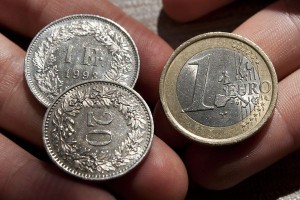 Yesterday’s trade saw EUR/CHF within the range of 1.2055-1.2086. The pair closed at 1.2068, gaining 0.02% on a daily basis.
Yesterday’s trade saw EUR/CHF within the range of 1.2055-1.2086. The pair closed at 1.2068, gaining 0.02% on a daily basis.
At 6:42 GMT today EUR/CHF was down 0.02% for the day to trade at 1.2066. The pair touched a daily low at 1.2065 at 6:43 GMT.
Fundamental view
Euro zone
French Consumer Spending
Consumer spending in France probably dropped 0.3% in July compared to June, according to market expectations, following a 0.9% increase in June compared to May. The annualized index of consumer spending probably gained 1.1% in July. This indicator reflects the change in the overall value of inflation-adjusted consumer expenditures and provides a short-term view of consumer behavior in the country. Levels of spending usually indicate how strong consumer confidence is. Higher than expected rates of decrease would have a certain bearish effect on the euro. The National Institute of Statistics and Economic Studies is to release the official data at 6:45 GMT.
German unemployment
The number of the unemployed people in Germany probably dropped by 2 000 in September, according to the median forecast by experts, following an increase by 1 000 during August. A decrease implies that consumer spending may be more active, while the latter is tightly related to economic growth. An increase implies the opposite.
At the same time, the seasonally adjusted rate of unemployment in the country probably remained unchanged at 6.7% in September. In July 2.03 million people were unemployed, while compared with July 2013, their number dropped by 215 000, or 9.4%, according to Destatis. In July approximately 42.6 million persons resident in Germany were in employment, according to provisional figures, while compared with July last year, this was an increase by 344 000 persons, or 0.8%.
In case the number of the unemployed decreased more than projected and the unemployment rate dropped, this would have a bullish effect on the euro. The Federal Statistics Office will release the official data at 7:55 GMT.
Italian unemployment
The rate of unemployment in Italy probably remained steady at 12.6% in August. In July the number of unemployed persons was reported at 3.22 million, or an increase by 2.2% in comparison with the prior month. Unemployment rate among persons aged 15-24 was 42.9% in July, or a drop by 0.8 percentage points compared to June, according to data by Istat. The number of people employed was reduced to 22.36 million in July, or a 0.2% decrease compared to a month ago. In case the rate of unemployment lowered, this might provide support to the common currency. Istat is to report the official rate at 8:00 GMT.
Euro zone Harmonized CPI and rate of unemployment
The annualized preliminary consumer price index in the Euro zone, evaluated in accordance with Eurostat’s harmonized methodology, probably fell to 0.3% in September, according to the median estimate by experts. If confirmed, this would be the lowest level of the HICP since October 2009. In August the HICP has been revised up to 0.4%, up from a preliminary estimate of 0.3%. Last month negative annual inflation was observed in Spain (-0.5%), Estonia, Greece, Italy (all -0.2%), Portugal (-0.1%), according to Eurostat. The most considerable upward impacts to annual inflation in the Euro region came from restaurants & cafés (+0.08 percentage points), rents (+0.07%) and maintenance of vehicles (+0.05%), while fuels for transport (-0.17%), fruit (-0.12%) and telecommunications (-0.11%) caused the largest downward impacts.
The index shows the change in price levels of a basket of goods and services from consumer’s perspective and also reflects purchasing trends. The main components of the HICP are food, alcohol and tobacco (accounting for 19% of the total weight), energy (11%), non-energy industrial goods (29%) and services (41%).
The HICP is used to evaluate and compare inflation rates between Member States, according to Art. 121 of the Amsterdam’s Agreement and directives by the European Central Bank (ECB), in order the latter to achieve price stability and the implementation of monetary policy. The HICP aggregates are calculated as a weighted average of each member state’s HICP components.
In case the HICP slowed down more than anticipated, thus, distancing from the 2% inflation objective set by the ECB, this would mount selling pressure on the euro, because of the greater possibility of introducing additional monetary policy measures in order to stimulate economic activity.
The annualized preliminary Core HICP for September probably matched the final Core HICP for August, reported at 0.9% on September 17th. In July annualized core inflation was reported at 0.8%. This index excludes volatile categories such as food, energy, alcohol and tobacco. Eurostat is scheduled to release the official inflation data at 9:00 GMT.
At the same hour, Eurostat will announce the rate of unemployment in the Euro region for August. It probably was at 11.5%, or matching the rate in July and June and also being the lowest since September 2012. 24.850 million persons in the European Union, of whom 18.409 million were in the Euro Area, were unemployed in July, according to Eurostat. Compared with June, the number of people unemployed dropped by 41 000 in the EU28 and remained almost unchanged in the Euro Area. In comparison with July 2013, the unemployed were 1.634 million less in the EU28 and 725 000 less in the Euro Area.
Unemployed are considered to be all persons aged between 15 and 74, who have not been hired during the survey period, have been actively seeking employment during the past four weeks and are able to accept any job proposition right away or in two weeks time. A drop in unemployment would support the single currency.
Italian consumer inflation
Italys annualized preliminary index of consumer prices (CPI) probably climbed to 0.0% in September, according to market expectations. In August the annualized CPI was reported at -0.1%, due to a drop in enery prices. This was the first time in almost 55 years, when Italian consumer inflation entered negative territory. Prices of energy fell at an annualized rate of 3.6% in August, mostly driven by a 1.2% drop in cost of non-regulated energy products. Additional downward pressures came from food prices (-0.5%), and communication (-9.0%), according to Istat. In July the annualized consumer inflation was at 0.1%.
Key categories, included in Italys Consumer Price Index, are food and non-alcoholic beverages (accounting for 16% of total weight), transport (15%), restaurants and hotels (11%) and housing, water, electricity and other fuels (10%). Other categories are clothing and footwear (9%), furnishing and household equipment (8%), recreation and culture (8%) and health (also 8%). Communication, education, alcoholic beverages, tobacco and other goods and services comprise the remaining 15% of the index.
Nations annualized preliminary CPI, evaluated in accordance with the harmonized methodology, probably improved to -0.1% in September, from -0.2% in August. The National Institute of Statistics (ISTAT) is to release the official CPI report at 9:00 GMT.
Switzerland
The KOF (Konjunkturforschungsstelle) economic barometer in Switzerland probably fell to a reading of 99.1 in September from 99.5 in August. It reflects the level of optimism that company executives have about the performance of the economy and how they assess their organizations’ prospects during the following six months. The KOF economic barometer is based on a multi-sectoral design with three modules. The most important module is GDP, which does not include construction and banking sectors, and accounts for 92% of nations total GDP. It is also known as Core GDP. The other two modules are construction and banking. In case of predominant optimism (respectively, an increase in the barometer), the Swiss franc would receive a boost. The official KOF reading is due out at 7:00 GMT.
Technical view
According to Binary Tribune’s daily analysis, the central pivot point for the pair is at 1.2070. In case EUR/CHF manages to breach the first resistance level at 1.2084, it will probably continue up to test 1.2101. In case the second key resistance is broken, the pair will probably attempt to advance to 1.2115.
If EUR/CHF manages to breach the first key support at 1.2053, it will probably continue to slide and test 1.2039. With this second key support broken, the movement to the downside will probably continue to 1.2022.
The mid-Pivot levels for today are as follows: M1 – 1.2031, M2 – 1.2046, M3 – 1.2062, M4 – 1.2077, M5 – 1.2093, M6 – 1.2108.
In weekly terms, the central pivot point is at 1.2073. The three key resistance levels are as follows: R1 – 1.2092, R2 – 1.2112, R3 – 1.2131. The three key support levels are: S1 – 1.2053, S2 – 1.2034, S3 – 1.2014.





